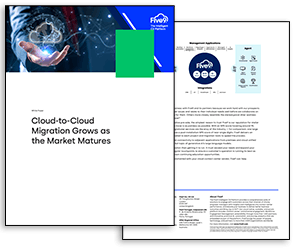The word ‘virtual’ can be defined as ‘not physically existing as such but made by computer software to appear to do so’. While the dictionary captures part of the definition we’re looking for, when applied to the phrase ‘virtual contact centre’ the interpretation doesn’t go far enough. Clearly we need a broader definition. We could say that a virtual contact centre is something that enables:
- Operations to no longer be constrained by location, breaking down walls or barriers.
- High availability IP network with end-to-end quality of service for both the LAN and WAN. This is a key enabling technology and provides the ubiquitous transport required by all the key resource elements of a virtual contact centre. It’s worth noting that businesses in general are now able to plan for a more data-centre-centric approach to all their applications.
- The centralisation of voice processing, contact centre and related applications while allowing distribution of inbound and outbound call routing from and to the PSTN. Economies of scale and call handling efficiency are much improved by this model.
- Agents to work from virtually anywhere that a secure and fast IP connection can be provided. The prevalence of high-speed broadband supports the notion of agents working with no more than a laptop and a headset at a home office location.
- Supervisors and managers to have easy access to consolidated real-time and historical reporting data across thousands of agents. By centralising the voice processing and skills-based routing engines, reporting is also centralised.
- More flexible working and business continuity from the perspective of the agents; facilitating improved agent morale from a hygiene factor perspective. Work–life balance can be better accommodated; it has been found that agent retention, morale and the available talent pool is all improved. Business continuity is improved as events that stop commuting or a primary workplace from being available have less of an impact.
- Easier business continuity and disaster recovery planning. The contact centre can be virtualised across two locations to provide geographic redundancy. The agents and gateways can all be serviced from the alternative site via IP.
- Business process engineering with Unified Communications and Service Oriented Architecture (SOA). Knowledge workers can be delivered into the call interaction with the customer to improve customer satisfaction and to allow front-line agents to respond more quickly to customer calls.
It’s fair to say that the virtual contact centre can mean different things to different call centre managers but in essence the virtual contact centre affords you exceptional flexibility.
Now that we know what a virtual call centre is, how should I go about building one?
In order to construct a virtual contact centre various technological and business considerations should be taken into account. If a more traditional estate of individually sited contact centres is in place; perhaps even networked via E1 or IP TIE trunks, is it conducive to being upgraded to fulfil the virtual contact centre? In general, most vendors offer an upgrade path to support the virtual model, so it is likely that this test would be passed. Ask the question though.
It is likely that the IP network infrastructure, both the LAN and the WAN, will need to be brought up to date. To be confident of supporting voice and other multimedia communication methods – real time (voice), near real time instant messaging (IM) and non-real time (email) – the network must be assessed end to end. The LAN edge of the network will need to support Power over Ethernet (PoE) for simple deployment of IP telephones. Quality of service policies will need to be marked in packets to be honoured across the LAN and the WAN to ensure voice quality is not compromised. Security may be an important consideration, with port-based security at the LAN edge at one end of the spectrum, and perhaps full encryption of the voice signalling and media paths and at the other.
Note: With respect to encryption of media paths; be aware that IP line-side call recording, fairly typical these days for training- and transaction-based fault resolution, are not best served with encrypted media paths as call recorders are not in general able to decrypt the conversation that they receive.
As part of the IP network planning phase, central and remote locations will need to be looked at. An IP PABX is able to be installed across a large geographical area whilst retaining a single node identity; that is to say, it’s not made up of many call servers networked together, but is a single call server deployed across multiple sites. For example, IP gateways can be located locally to allow customers to dial a number that’s local from their perspective; this may help the company to appear to maintain neighbourhood presence. Due to the nature of IP Telephony the call processing software and hardware can be decoupled by many hundreds of miles from the actual physical location of the caller or agent. With this in mind it is easy to see how telephony processing is simplified: single call-routing database, fewer points of interface to CTI-based applications, simpler skills-based routing and configuration, etc.
You’ve probably deduced by now that from a business continuity perspective the IP PABX offers better geographic redundancy. This can be explained by the virtualisation of all the traditional elements of the PABX over IP. If one part becomes unavailable, the call processing engine, for example, the other elements of the solution can fail-over across the virtual connections in the IP cloud. This mirrors the model that we now see enterprises adopting, or at least moving toward: the primary and backup data centre model. It is ironic to think that the high-value customer relationship management (CRM) application that your agents may currently be using to improve their responsiveness to customer enquiries is probably served by the same architectural model.
Once the IP telephony infrastructure is in place the applications that support and bring the virtual contact to life can be deployed. As mentioned earlier, the simplification of the number of points of call processing reveals intuitively that fewer points of application integration, for example, CTI feeds, with the telephone system itself are required. This further promotes economies of scale and in turn simplifies how the applications can be deployed. If we again assume a data-centre-centric model, the world of communications and the world of IT would appear to be starting to converge.
So on the face of it the virtual contact centre would appear to answer many of the concerns commonly associated with multi-site contact centres, but there are some costs and issues that must not be overlooked. Firstly, it may require a complete replacement of the existing LAN and WAN infrastructure as opposed to a gradual evolution. This may not be possible for your business to consider as the business case may not stack up; although this should be weighed against all the potential benefits.
Another issue might be lack of control in respect of the dispersed workforce. Your company will need to put in place well-thought-out support systems, particularly for home-based agents. Regular visits may be required to ensure that a residence is appropriate to the work being undertaken, the issue of how training is given to the agent (e.g. regular e-learning opportunities) must be considered, workforce management needs to be set up in an appropriate way, and careful selection for remote agents is essential for success. Again these need to be weighed against the benefits, e.g. improved agent retention and productivity, ability to respond to work-life balance legislation in a positive way, etc.
What about other ways that a contact centre can be implemented?
Now a word on other methods of contact centre deployment. Clearly there are many different types of business out there. A smaller business might wish to deploy a small contact centre and thoughts and comments on the virtual contact centre in its entirety might appear slightly overwhelming. Of course, there is no reason why an ‘office in a box’ approach wouldn’t serve as well and offer some of the same advantages, e.g. agents IP-enabled to work from anywhere.
Larger and possibly more discrete contact centres can be networked using IP or ISDN TIE lines and networked contact centres then implemented; typically each contact centre software suite would be connected to each individual telephone node in the network. Now this might appear to be leading us toward issues of management and consolidated reporting. It is possible, however, with current software suites on the market to create part of the value offered by the truly virtual contact centre, such as a corporate rather than nodal licensing model, true consolidated reporting, etc. It does not, however, offer all the benefits of the fully virtual solution. On the other hand, networking at this level may allow better use of existing assets such as an existing fleet of digital telephones.
While this might look like a fait accompli, there are always experiences and questions that are asked that may dissuade you from considering the virtual approach. These include the following questions.
IP for the contact centre is great in theory but how does my business avoid the pitfalls of poor voice quality?
The foundation of the virtual contact centre requires a correctly engineered IP network for both the local and wide area infrastructure. Paramount in the deployment of VoIP, thereby ensuring a toll quality experience is end-to-end quality of service (QoS). While bandwidth limits the absolute number of calls that can be delivered simultaneously, QoS means the call will be intelligible and of an appropriate business quality.
Within the LAN infrastructure the minimum requirement is for layer two switching, and in all likelihood layer three switching also. Alongside this will be the practical requirement that PoE and QoS will need to be supported. Of course, the WAN will need to support and honour the QoS requirements of the voice traffic or the quality of experience for both the calling party (customer) and the called party (agent) could be quite disastrous. So to avoid the same frustration that the average mobile phone user faces on a train, plan the IP network correctly.
IP Networking has become the ubiquitous network layer for the converged networks of today and into the future. Engineered correctly, it provides for both quality of service and security through the use of protocols that take advantage of IP.
Is service availability and resilience best served by geographic separation; for example should I deploy two switches in two different locations?
The most suitable architecture in terms of availability and resilience is really best served by geographic separation. This must be seen in terms of both equipment and workplace availability and resilience. However, depending on the deployment options being looked at, this could be either two switches, perhaps networked (trunked), or a single switch geographically dispersed.
It should be realised, however, that single-location, highly resilient services are in operation today. If all the agents are required to work from a single location because of support requirements, security concerns and management needs, then a second location may only be useful to provide continuity of the operational software and hardware system. Unless disaster recovery rather than business continuity is important, a single site would be more than adequate. A more likely scenario is that a building’s power is lost, or that workers are unable to reach the workplace due to weather or other hazards.
Unless agents are able to work from home, and this may not be possible, then a second site full of equipment may be pointless.
How should the calls be delivered to my contact centre(s); for example should I use pre or post call routing?
To answer this question let’s review our understanding of the two terms:
- Pre-call routing allows for a call to be routed to a group of geographically dispersed contact centres using methods such as time-of-day routing, route on point of origin, percentage allocation routing, etc. This type of routing typically makes use of non-geographic numbers such as toll-free numbers.
- Post-call routing allows for the business’s contact centre solution to route the call once it has been received by either the carrier from an external user or perhaps through the private network from an internal user.
There are distinct advantages to pre-call routing if your contact centres are scattered across several sites. Firstly it allows the carrier to route the call to multiple customer locations based on customer requirements, without the need to deploy a completely integrated contact centre infrastructure which would typically be enabled across a single QoS-enabled IP WAN or networked PABXs.With some vendor software it is also possible for the carrier-network-based intelligence to interact with the customer premises-based equipment to ascertain where agents are available and even factor idle time in to the decision. This level of service from a carrier might prove to be a more expensive premium-type service above, say, time-of-day routing, which is considerably simpler. Another disadvantage is that calls from an internal number to the contact centre will not get routed via the carrier and therefore pre-call routing will be totally ineffective.
Post-call routing relies on a corporate network and an appropriate ACD or skills-based routing engine to get the call to an agent. There are a number of advantages to this approach but it does require either networking via voice trunks or IP networking a virtual contact centre to really be effective across multiple sites. If this imperative is met then corporate routing offers much more flexibility than routing in the carrier cloud. The call can also be routed potentially for the majority of its journey on the customer’s private network. It also offers flexibility to accept calls on direct dial-in (DDI) as well as non-geographic numbers.
Centralised call centres versus decentralised; which one tends to work best?
This question is interesting as it reveals the nature of call centre design, typically with respect to thinking on business continuity and disaster recovery and in respect of equipment and operational cost. For many years call centres were built in one place at a time offering service based on location. Businesses planning contact centres often cited that for business continuity reasons having a single, large location was not desirable and that a decentralised approach was the best one to adopt. However, the decentralised model has brought challenges with respect to the efficient use agents and how to create effective report consolidation across multiple sites. A way round this is to create a networked ACD environment although relatively expensive TIE trunks are required to achieve this.
However, there are many good reasons to centralise call centre operations, not least of which is the savings associated with less infrastructure through economies of scale and centralised management. Furthermore, performance tracking, accountability and productivity are typically easier in the centralised model.
Having said all that, the modern virtual contact centre leveraging a well-planned and high-availability WAN can deliver all the benefits of both centralisation and decentralisation.
Should I plan for the potential inclusion of SIP and/or SOA based solutions now or sometime in the future?
Within the context of the virtual contact centre the short answer is now. It is forecast that over the next five years both Session Initiation Protocol (SIP) and Service Oriented Architecture (SOA) will become primetime and business strategy should pay close attention to the potential these technologies can bring to the operational efficiency of contact centres.
A point to note about SIP is that in reality it is already here. Presence and Instant Messaging (IM) based solutions provided by SIP have been in use both across enterprises and in the broader private and residential user space for several years now. The benefit of building multimedia communications into the contact centre is that it allows a broader knowledge base to be made available to the customer, who is typically looking for a quick and accurate resolution to their call.
The VoIP-ready network infrastructure discussed earlier in this paper will typically be in good shape to deliver a SIP-based solution. Indeed, the virtual contact centre’s use of centralised voice intelligence for dial tone is architecturally similar to centralised SIP-based services. Agents armed with this capability will then be able to ‘see’ the availability of subject matter experts through presence information, potentially across the entire business. A customer call can then involve an agent answering the query by use of IM or perhaps conferencing the expert in live to the call. The rationale of extending the SIP service to the agent becomes very clear with these simple examples: fulfilling the promise of first-call resolution on a much more frequent basis.
The question of SOA is actually much broader than the integration opportunity that SIP can deliver. An SOA not only has the potential to integrate a much broader range of applications but it also simplifies the challenges that almost always come with such integration. Simply, SOA could be used to create a contact centre that better integrates various multimodal communications media (e.g. voice, email, IM, etc.) with applications such as CRM; CTI (computer telephony integration) I here you cry! Indeed, on the face of it, it may appear so, but CTI-based applications are notorious for taking many months of development and testing time to deliver their forecast value to the business in the contact centre environment. SOA-based applications are by their nature extensible, allowing much quicker development times, leading to both more agile business processes and realising value more quickly for the business.
An SOA as a framework utilising web services also builds upon a very large, previously untapped, developer community for the contact centre environment. The new generation of consumers has very quickly adapted to multimodal communication forms and now interacts in ways not really foreseen, such as on social networking sites and more recently in virtual worlds. The contact centre of some or all businesses will need, as they have always done before, to adapt to how customers want to communicate in a variety of preferred media types.
Conclusion
The majority of this article has expounded the virtues of building the virtual contact centre. It can allow a business incredible flexibility in deploying and potentially redeploying a contact centre in a completely different place if required. The ability to allow agents and indeed the supervisors and managers to work from anywhere and still retain effective real-time and historical reporting is highly attractive. Disadvantages potentially exist around perceived and actual loss of control, which will have to be addressed with effective workforce management and support systems for agents, both remote and local. It may also be that the requirements of the networking infrastructure cannot currently be met. There are alternative approaches of networking that may be considered that offer some of the benefits of a truly virtual contact centre but probably not all.
A key thought does occur though; with planning and guidance from the wider industry the virtual contact centre can reach out to the widest possible audience and serve both the consumer and enterprise with equal advantage.

Rick Hawkes – Sales Engineer – Nortel, EMEA
Author: Jo Robinson
Published On: 14th Jan 2009 - Last modified: 18th Feb 2020
Read more about - Customer Service Strategy, Cloud

















Dear Sir/Madam,
How do I build a Virtual Call Centre?
Benjamin Kusi
Do you think that virtual call center will have their future only in outbound calls or will more an more companies use them for inbound calls? I´ve heard Apple is shifting more and more to people working from home, but newer companies like Zappos see their call center as so important, that they want to keep everything under the same roof.